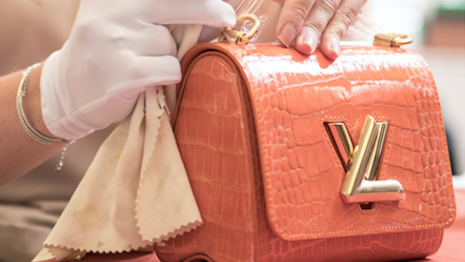By Nora Howe
Younger consumers are increasingly verifying supply chains and sustainability credentials. Image credit: Positive Luxury
More luxury brands are touting their sustainable initiatives — from traceability to supply chain collaboration and more — to reach conscious consumers, but only a select number of affluents are looking into the details.
Over the past few years, and dramatically accelerated by the health and environmental crises, consumers and brands have shifted their mindsets and business strategies to better serve the global sustainability agenda. While swapping out leather for faux alternatives may be enough to convince some conscious consumers, experts argue long-term change stems from how companies conduct their supply chains, resourcing and traceability.
“As we move further into 2021, the luxury industry will be under tighter surveillance for being purpose-driven and socially responsible,” said Diana Verde Nieto, founder of Positive Luxury, London. “Environmental, Social and Governance (ESG) will play a much bigger role in the boardroom, and Gen Z and millennials, in particular, will vote with the money they spend.
“At the same time, luxury brands will need to demonstrate empathy in the context of newly-emerging emotional concerns and needs, focusing on community building and support over profit as a sole objective.”
Consumers care
Consumers have started pledging allegiance to brands across multiple industries that have promoted sustainability practices and publicly celebrated environmentally-friendly initiatives, but how many affluents actively explore the logistical side of these strategies?
According to luxury market researcher Altiant’s GLAM tracker, in Q2021, 49 percent of affluents rated sustainability with the importance of four or five on a five-point scale, indicating that many consumers recognize the ongoing need for an environmental focus.
“With the rise of natural disasters and pressure for more sustainable practice in all industries, particularly fashion, which is often found responsible for overflowing landfills, consumer values have shifted across markets in the United Kingdom, the United States, France and China,” said Meryam Schneider, vice president of marketing and partnerships at Altiant, Paris. “While we’ve seen steady growth in how wealthy consumers value social and environmental actions from their favorite luxury brands or their loyal wealth management institutions, this trend has undoubtedly accelerated during the pandemic.
U.S. jeweler Tiffany & Co. shares where its diamonds were crafted. Image credit: Tiffany & Co.
“We are seeing consumers put a lot more emphasis on sustainability, acting on their beliefs and increasingly expecting brands to serve alongside them towards these conscious goals,” she said. “Many brands now overtly talk about their CSR credentials and publicly commit to them, resonating strongly with the public.”
Through its research, Altiant also found that wealthy consumers are approaching the luxury rental or pre-loved market with less stigma, with 39 percent of luxury renters preferring to rent as they believe it reduces their environmental footprint.
According to Euromonitor’s “Top 10 Global Consumer Trends” report, consumers are taking social and environmental issues more seriously, rewarding businesses that use their profits for good post-pandemic. Brands that rebuild a greener and more equitable world could gain not only a competitive advantage but also the necessary societal trust to operate (see story).
Young consumers, especially, overwhelmingly believe that their choices and actions make a difference to the world and that giving back to those in need is of the utmost importance.
“To win over consumers today, luxury companies need to adopt agile innovation and redefine their strategies over price, values and activism to align with the new priorities and spending behavior in the ‘new normal,’” Ms. Verde Nieto said.
While the concept of sustainability is becoming universally accepted, it appears that younger consumers, primarily, are actively diving deeper into the logistical side of brand sustainability.
In 2018, Altiant found that 70 to 90 percent of the wealthy or high-net-worth population in the U.K., U.S. and China trusted the sustainability and ethics-related claims from luxury brands. Among that group, 27 percent, globally, were paying very close attention.
“We have seen many consumers, particularly those under the age of 40, being willing to conduct this research before deciding whether they want to buy a product,” Ms. Schneider said. “It can be such a key selling point, and now brands are making this information visible to customers.
“There is a certain level of interest in the logistical side of sustainability,” she said. “Still, many wealthy consumers appear to want this sustainability information to be clearly and concisely presented, and it has to be something the brand can fully back up.”
In October 2020, U.S. jewelry Tiffany & Co. became the first in its industry to disclose where each of its diamonds is crafted and set. The New York-based jeweler now shares the full craftsmanship journey of its newly sourced, individually registered diamonds that are 0.18 carats or larger.
This announcement came a year after Tiffany became the first luxury jeweler to provide the provenance of its individually registered diamonds (see story).
French fashion house Louis Vuitton earned Positive Luxury’s Butterfly Mark for its measurable impact and company-wide commitments to sustainability. Image credit: Louis Vuitton
“People fall in love with products at first sight, and then want an easy way to justify spending so that look for symbols or cues that give them reassurance,” Ms. Verde Nieto said. “That is the role of certification, especially certification like the Butterfly Mark that looks at the business from an ESG+ (Environmental, Social Governance and Innovation) perspective.”
The Butterfly Mark is Positive Luxury’s certification that highlights brands that are committed to having a positive impact on nature and society.
Brand responsibility
When it comes to responsibility for sustainable consumption, experts believe the initial onus is on brands to provide consumers with sustainable options and services, then it falls on the consumer to shift their purchasing behavior.
“Consumers are looking to brands to show them the path to go down, and many are willing to follow if the sustainable case is compelling,” Ms. Schneider said. “Consumers expect brands to do the right thing and act appropriately with their sustainability strategies, even if it means they have to pay a little more themselves.”
During a panel at the Financial Times Business of Luxury Summit in November 2020, a director from Selfridges discussed the retailers’ sustainability initiative Project Earth, which approaches sustainability through three lenses: materials, models and mindset.
Through the materials lens, Selfridges is able to share the material components of a product, such as organic cotton or denim produced with less water. Through the model lens, they are focusing on the consumption of retail and upending the notion of owning fashion by creating resale and rental platforms.
Through the mindset lens, the company discusses issues such as overconsumption and environmental initiatives while amplifying voices in the retail environment (see story).
“People cannot buy sustainably unless brands produce responsibly,” Ms. Verde Nieto said. “Having said that, there is a visible shift from buying products to an alternative commerce model, such as renting or leasing.
“This is why brands like Vestiaire Collective and RealReal are growing and growing.”
The secondhand fashion sector is forecast to be worth more than $60 billion by 2025. The growth is being accelerated by younger consumers who keep sustainability top of mind, as well as more interest in online communities and social shopping (see story).
Italian fashion house Gucci partnered with resale platform The RealReal in October 2020 to set up an online shop featuring pre-owned Gucci pieces from past collections (see story).
“Brands that only vaguely or fleetingly refer to their sustainable efforts may be treated with a degree of suspicion by increasingly savvy shoppers,” Ms. Schneider said. “The idea that consumers perceive luxury items as less desirable when they are labeled as sustainable or used recycled materials is part of the past.
“The risk of being perceived as a greenwashing organization is undoubtedly present, but I believe that green fatigue from the consumer can be a higher risk,” she said. “By now, the basics of environmental and social responsibility should be integrated into luxury companies’ business models, so now they should focus on innovation and consumer experience — how it feels to experience sustainable luxury.”



